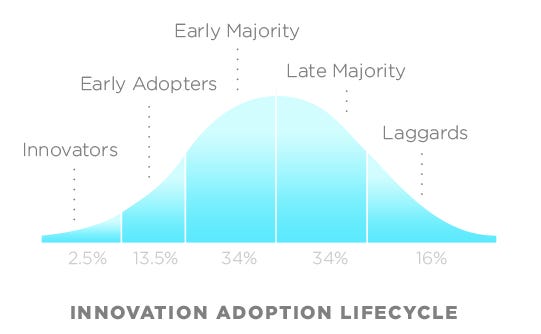
Pivotal executives ring the opening bell on the New York Stock Exchange on the day of its 2018 IPO. (NYSE Photo)
Welcome to Mostly Cloudy! Don’t forget to take those vacation days.
This (Actually, Last) Week in Cloud: The Hybrid Effect
As I packed up the car last week for a four-day camping trip on the north side of Mount Hood, news broke that corporate siblings VMware and Pivotal are in talks to combine forces, less than seven years after Pivotal was created out of various pieces from the former EMC-VMware tech conglomerate and a little over a year since Pivotal’s IPO.
Under the terms of the proposed agreement, VMware would pay the exact same price per share ($15) that Pivotal chose for its listing price in April 2018, which CEO Rob Mee told me at the time was “a message of strength and independence.” Life comes at you fast in enterprise tech, but the talks are also a reflection of how important hybrid cloud strategies have become to the future of tech infrastructure.

VMware CEO Pat Gelsinger (VMware Photo)
Pivotal’s distribution of the Cloud Foundry open-source software helps companies with older tech assets catch up with the Joneses, giving them modern software development and infrastructure management tools without having to make wholesale changes to their existing applications. It’s a set of training wheels for the eventual transition to the cloud, and that strategy is gaining traction as it becomes clear that both cloud computing and traditional on-premises applications are here to stay.
VMware is keenly aware of this trend, and has navigated the transition from on-premises computing to cloud-centric computing as ably as any other enterprise tech company born in the earlier era. This is the thinking behind IBM’s huge purchase of Red Hat, which theoretically gives IBM clients with aging servers the tools to modernize their infrastructure without causing a lot of pain.
Cloud vendors are also pouring a lot of resources into hybrid cloud strategies targeted at what the consultants call the “early majority” stage of cloud computing adopters.

(Photo courtesy Wikimedia Commons / cc 3.0)
Amazon Web Services will likely launch its AWS Outposts service with VMware at VMworld in late August, and Microsoft Azure has made a lot of progress helping companies running Windows applications in their data centers tap into Azure’s cloud resources. Google Cloud’s biggest product launch this year was Anthos, a multicloud and hybrid cloud tool designed for customers that need help managing this transition.
Pivotal is well positioned to capture this type of customer, but it has had a rocky first year on the public markets. In June it updated its full-year revenue guidance with a new target well below what analysts had been expecting for the year, and its shares took a beating.
Mee chalked up the shortfall to “a complex technology landscape that is lengthening our sales cycle,” according to CNBC. Lengthy sales cycles are the bane of many an enterprise tech company’s existence, and those cycles will only get more complex as cloud tech vendors increase their outreach to companies that have years of legacy baggage in need of cleaning.
Companies that wanted to modernize their tech infrastructure were once told that cloud vendors would soon own all the workloads, and that resisting the inevitable would damage their competitiveness. Some day that prediction might come true, but we’re a long way from that future; inertia is a powerful force, and CIOs get fired for breaking mission-critical applications in pursuit of the hottest enterprise toys on the market.
VMware has assembled an interesting assortment of products and talented employees focused on this hybrid cloud customer, thanks to its wide-ranging partnership with AWS and deep history inside the data center. Adding Pivotal would give it another hybrid cloud and multicloud tool in that basket, and that could help the combined company navigate a looming recession that could force a lot of potential customers thinking about modernizing their tech infrastructure to focus instead on ways to maximize their existing investments.
And Now, A Word…


Around the Cloud
Jensen Huang interview: Why AI is the single most powerful force of our time (Venturebeat)
I’m a bit of a skeptic when it comes to the immediate impact of AI, which tech vendors have been hyping as The Future of Everything for several years now. But this interview with Nvidia CEO Jensen Huang, who foresaw the need for specialized AI processing architectures long before much of the competition, is worth reading.
Microsoft acquires jClarity for optimizing Java workloads on Azure (ZDnet)
Java is still a very widely used programming language, but its future has been cloudy thanks to Oracle’s decision to cash in on the last remaining asset from its Sun Microsystems acquisition by charging for Java SE. AWS has released Corretto, an alternative Java JDK distribution, and now Microsoft has its own open JDK alternative thanks to the acquisition of jClarity.
Big Customers Pressure AWS to Step Up Open Source Support (The Information)
AWS has spent a lot of time and effort trying to bolster its image within the open-source community over the last few years, but it has been a little hesitant when it comes to embracing a new generation of open-source projects built to enable businesses to run workloads on multiple clouds. It was slow to support Kubernetes, and now The Information reports that several key AWS customers are urging it to do more with Spinnaker, an open-source project developed at Netflix that enables continuous delivery across multiple clouds.
To Power A.I., Start-Up Creates a Giant Computer Chip (The New York Times)

This is a really big chip. (Cerebras Photo)
It used to be a running joke among chip reporters that at every new chip event, we could just file stories entitled “Smaller, Faster, Cheaper” and hit the bar. Times change, and a startup called Cerebras thinks AI workloads will run better on its massive chip, which The New York Times described as the size of a dinner plate.
Basecamp's cofounder explains why it ditched Google Cloud for Amazon this summer (Business Insider)
Google’s decision to pitch itself as the most reliable cloud in the business at its April Google Cloud Next event continues to look questionable. The third “frustrating” outage was the charm for Basecamp, which decided to move to AWS this year because of the cloud leader’s experience and resiliency.
How malformed packets caused CenturyLink’s 37-hour, nationwide outage (Ars Technica)
CenturyLink’s December 2018 outage took down 911 service across several parts of the country, which is the kind of thing that makes the federal government sit up and take notice. A newly released report from the Federal Communications Commission provides new details on the debacle, but it’s still not clear if CenturyLink will face any penalties from the outage.
Women Leave Tech Jobs Because They Can’t Climb the Ladder (IEEE Spectrum)
“Men have no special skills that enable them to run technology companies. There are just way more of them, and they’re more aggressive about getting to the next level.” Several years ago YouTube CEO Susan Wojcicki articulated what a recent report from the IEEE confirms: women are leaving the tech industry because they don’t see a path to leadership positions that are overwhelmingly held by men.
The View From On High: How To Beat Moore’s Law (The Next Platform)
Now that just about everybody outside of Intel has acknowledged that Gordon Moore’s famous axiom has run its course, the question becomes what to do about it. In an interview with The Next Platform, AMD CEO Lisa Su explained what the once and future chip upstart is doing to improve performance as it becomes harder and harder to shrink transistors.
How to avoid getting sued in your Oracle-to-the-cloud migration (Tech Republic)
The fact that this story even needs to be written is quite the commentary on long-ranging effects of legacy IT. Tech Republic takes a look at what current Oracle customers face when thinking about a cloud migration, and how the new boss might actually resemble the old boss to some extent.



